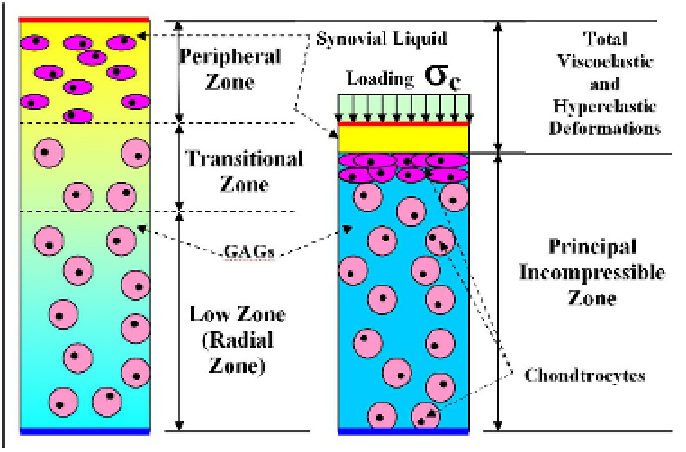Biomedical Engineering Reference
In-Depth Information
1.
in transferring physiological loads into the subchondral bone and further to the
spongious bone,
2.
in ensuring the lubrication of articular plateaus of joints and
3.
in protecting the structural components of cartilage from higher physiological forces.
The macromolecular structure of AC in the peripheral zone (Fig. 1.) has two fundamental
biomechanical safety functions, i.e. to regulate the lubrication of articular surfaces and to
protect the chondrocytes and extracellular matrix from high loading.
The rheological properties of SF play the key role in the achievement of the optimum
hyaluronan concentration.
Fig. 1. Complex structural system of articular cartilage (collagen fibres of 2
nd
type are not
drawn)
The properties of SF in the gap between the opposite surfaces of articulate cartilage are not
homogeneous during loading. The properties of SF change not only during biomechanical
loading, but also during each individual's life time. The viscous properties of this fluid
undergo changes (in time) due to mechanical loading. As a consequence of its very specific
rheological characteristics, SF very efficiently adapts to external biomechanical effects. Exact
knowledge of the rheological properties of synovial fluid is a key tool for the preservation
and treatment of AC. The significance of the specific role of SF viscosity and viscosity
deviations from predetermined physiological values were first pointed out as early as the
1950s to 1990s (Johnson et al., 1955; Bloch et al., 1963; Ferguson et al., 1968; Anadere et al.,
1979; Schurz & Ribitsch, 1987; Safari et al., 1990 etc.). The defects of concentrations of the
dispersion rate components were noticed by Mori (Mori et al., 2002). In this respect, it
cannot be overlooked that mechanical properties of SF very strongly depend on the
molecular weight of the dispersion rate (Sundblad et al., 1953; Scott & Heatley, 1999; Yanaki
et al., 1990; Lapcik et al., 1998) and also on changes in the aggregations of macromolecular
complexes in SF during mechanical effects (Myers et al., 1966; Ferguson et al., 1968; Nuki &
Ferguson, 1971; Anadere et al., 1979 and Schurz & Ribitsch, 1987).
Synovial fluid is a viscous liquid characterized by the apparent viscosity η. This viscosity
depends on stress and the time during which the stress acts. SF is found in the pores of the





